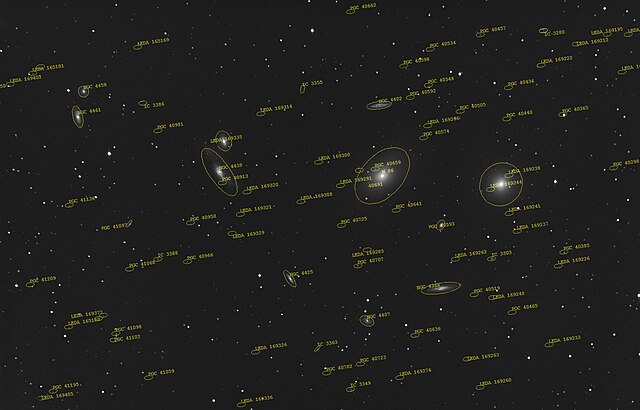The Virgo Cluster is a large cluster of galaxies whose center is 53.8 ± 0.3 Mly away in the constellation Virgo. Comprising approximately 1,300 member galaxies, the cluster forms the heart of the larger Virgo Supercluster, of which the Local Group is a member. The Local Group actually experiences the mass of the Virgo Supercluster as the Virgocentric flow. It is estimated that the Virgo Cluster's mass is 1.2×1015 M☉ out to 8 degrees of the cluster's center or a radius of about 2.2 Mpc.
Virgo Cluster showing the diffuse light between member galaxies. Messier 87 is the largest galaxy (lower left).
Turbulence may prevent galaxy clusters from cooling (Chandra X-ray).
Photograph of the Virgo Cluster with labelled galaxies
A galaxy cluster, or a cluster of galaxies, is a structure that consists of anywhere from hundreds to thousands of galaxies that are bound together by gravity, with typical masses ranging from 1014 to 1015 solar masses. They are the second-largest known gravitationally bound structures in the universe after some superclusters (of which only one, the Shapley Supercluster, is known to be bound). They were believed to be the largest known structures in the universe until the 1980s, when superclusters were discovered. One of the key features of clusters is the intracluster medium (ICM). The ICM consists of heated gas between the galaxies and has a peak temperature between 2–15 keV that is dependent on the total mass of the cluster. Galaxy clusters should not be confused with galactic clusters (also known as open clusters), which are star clusters within galaxies, or with globular clusters, which typically orbit galaxies. Small aggregates of galaxies are referred to as galaxy groups rather than clusters of galaxies. The galaxy groups and clusters can themselves cluster together to form superclusters.

Composite image of five galaxies clustered together just 600 million years after the Universe's birth
Galaxy cluster IDCS J1426 is located 10 billion light-years from Earth and has the mass of almost 500 trillion suns (multi-wavelength image: X-rays in blue, visible light in green, and infrared light in red).
Abell 2744 galaxy cluster – extremely distant galaxies revealed by gravitational lensing (16 October 2014).
Galaxy cluster SPT-CL J0615-5746.







